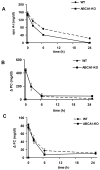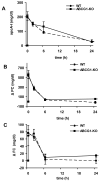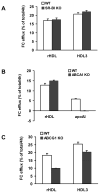Pathways by which reconstituted high-density lipoprotein mobilizes free cholesterol from whole body and from macrophages
- PMID: 20018934
- PMCID: PMC2842952
- DOI: 10.1161/ATVBAHA.109.196105
Pathways by which reconstituted high-density lipoprotein mobilizes free cholesterol from whole body and from macrophages
Abstract
Objective: Reconstituted high-density lipoprotein (rHDL) is of interest as a potential novel therapy for atherosclerosis because of its ability to promote free cholesterol (FC) mobilization after intravenous administration. We performed studies to identify the underlying molecular mechanisms by which rHDL promote FC mobilization from whole body in vivo and macrophages in vitro.
Methods and results: Wild-type (WT), SR-BI knockout (KO), ABCA1 KO, and ABCG1 KO mice received either rHDL or phosphate-buffered saline intravenously. Blood was drawn before and at several time points after injection for apolipoprotein A-I, phosphatidylcholine, and FC measurement. In WT mice, serum FC peaked at 20 minutes and rapidly returned toward baseline levels by 24 hours. Unexpectedly, ABCA1 KO and ABCG1 KO mice did not differ from WT mice regarding the kinetics of FC mobilization. In contrast, in SR-BI KO mice the increase in FC level at 20 minutes was only 10% of that in control mice (P<0.01). Bone marrow-derived macrophages from WT, SR-BI O, ABCA1 KO, and ABCG1 KO mice were incubated in vitro with rHDL and cholesterol efflux was determined. Efflux from SR-BI KO and ABCA1 KO macrophages was not different from WT macrophages. In contrast, efflux from ABCG1 KO macrophages was approximately 50% lower as compared with WT macrophages (P<0.001).
Conclusions: The bulk mobilization of FC observed in circulation after rHDL administration is primarily mediated by SR-BI. However, cholesterol mobilization from macrophages to rHDL is primarily mediated by ABCG1.
Conflict of interest statement
Disclosures: None.
Figures





References
-
- Cuchel M, Rader DJ. Macrophage reverse cholesterol transport: key to the regression of atherosclerosis? Circulation. 2006;113:2548–2555. - PubMed
-
- Saito H, Lund-Katz S, Phillips MC. Contributions of domain structure and lipid interaction to the functionality of exchangeable human apolipoproteins. Prog Lipid Res. 2004;43:350–380. - PubMed
-
- Nissen SE, Tsunoda T, Tuzcu EM, Schoenhagen P, Cooper CJ, Yasin M, Eaton GM, Lauer MA, Sheldon WS, Grines CL, Halpern S, Crowe T, Blankenship JC, Kerensky R. Effect of recombinant ApoA-I Milano on coronary atherosclerosis in patients with acute coronary syndromes: a randomized controlled trial. Jama. 2003;290:2292–2300. - PubMed
-
- Tardif JC, Gregoire J, L'Allier PL, Ibrahim R, Lesperance J, Heinonen TM, Kouz S, Berry C, Basser R, Lavoie MA, Guertin MC, Rodes-Cabau J. Effects of reconstituted high-density lipoprotein infusions on coronary atherosclerosis: a randomized controlled trial. Jama. 2007;297:1675–1682. - PubMed
-
- Shaw JA, Bobik A, Murphy A, Kanellakis P, Blombery P, Mukhamedova N, Woollard K, Lyon S, Sviridov D, Dart AM. Infusion of reconstituted high-density lipoprotein leads to acute changes in human atherosclerotic plaque. Circ Res. 2008;103:1084–1091. - PubMed
Publication types
MeSH terms
Substances
Grants and funding
LinkOut - more resources
Full Text Sources
Other Literature Sources
Medical
Molecular Biology Databases
Research Materials

